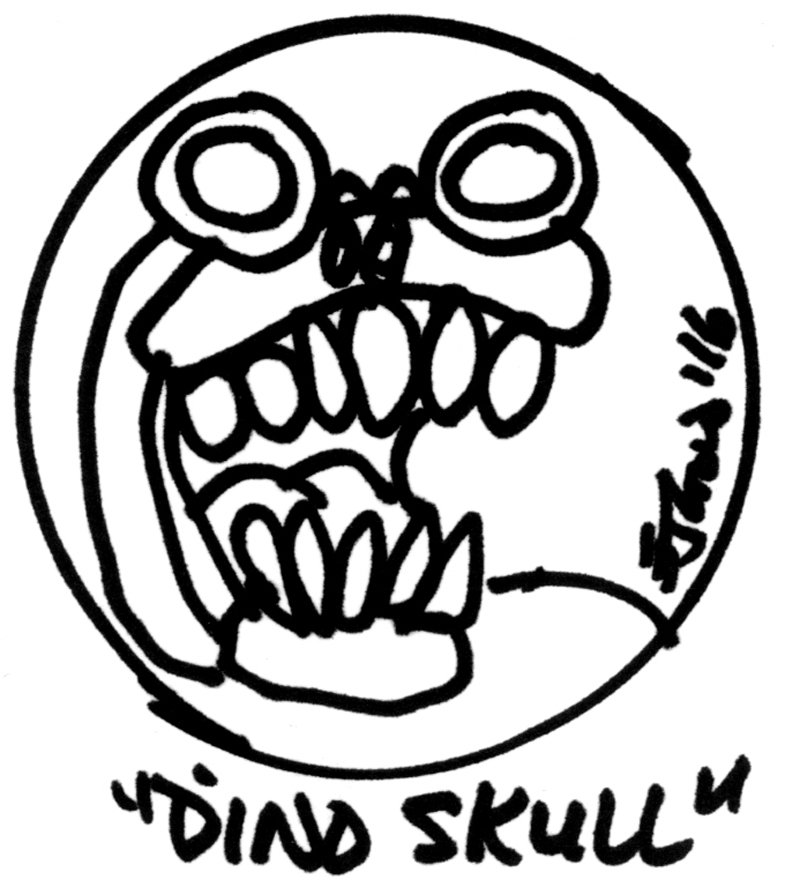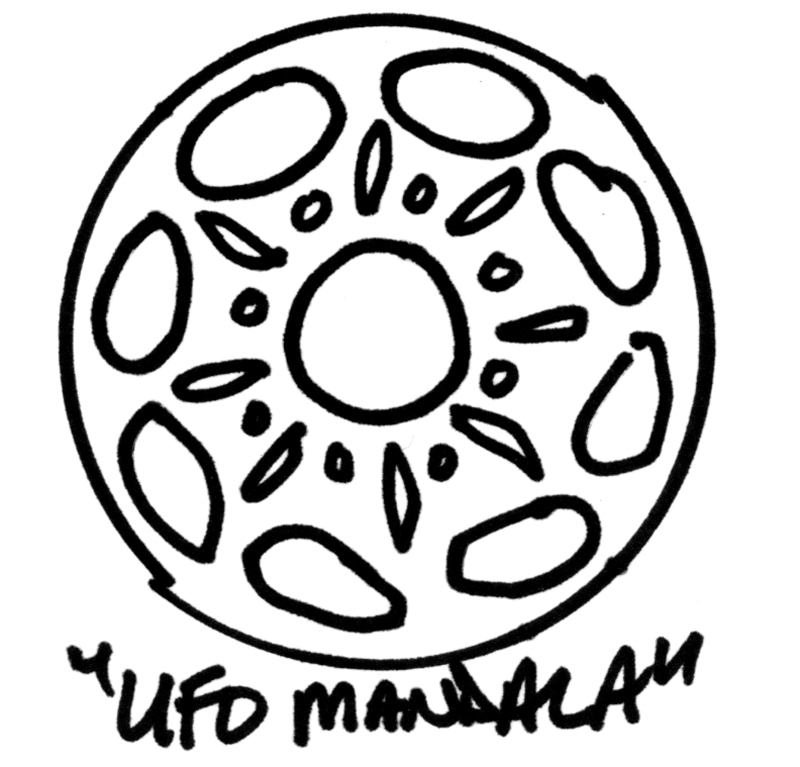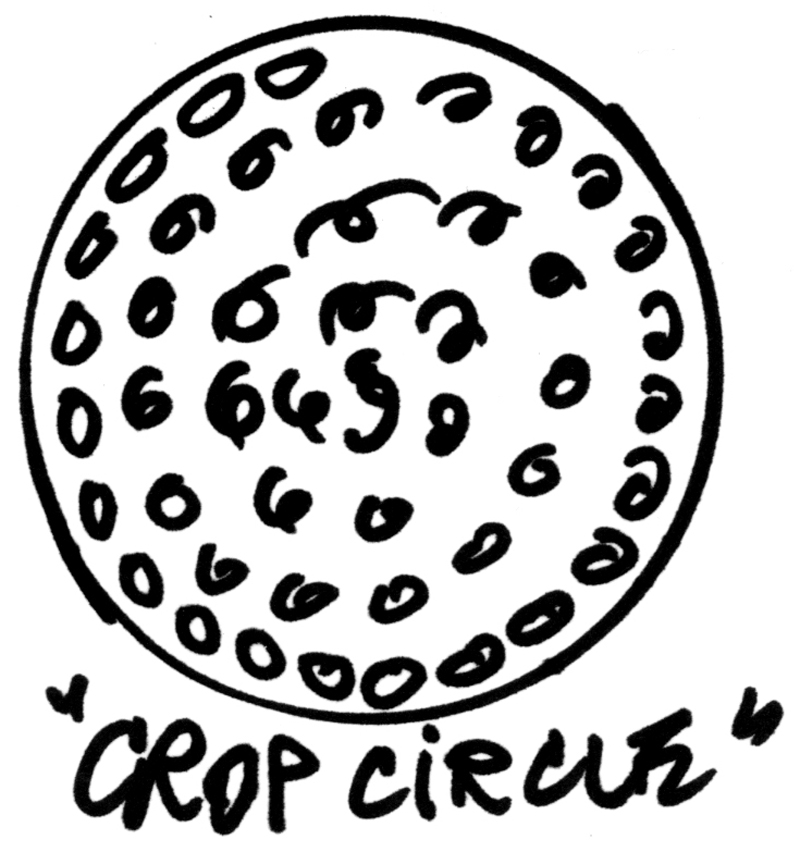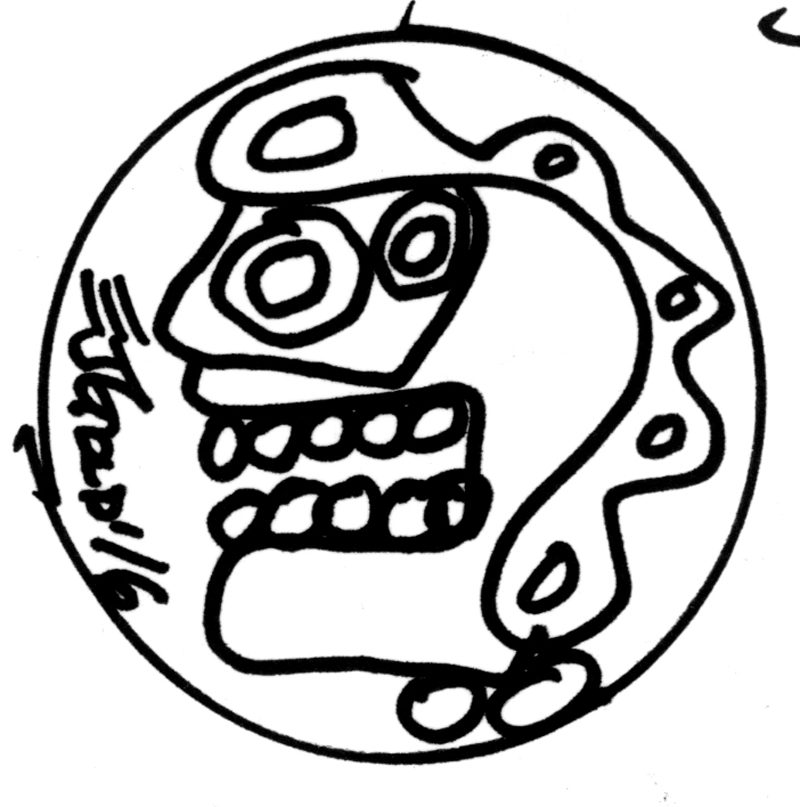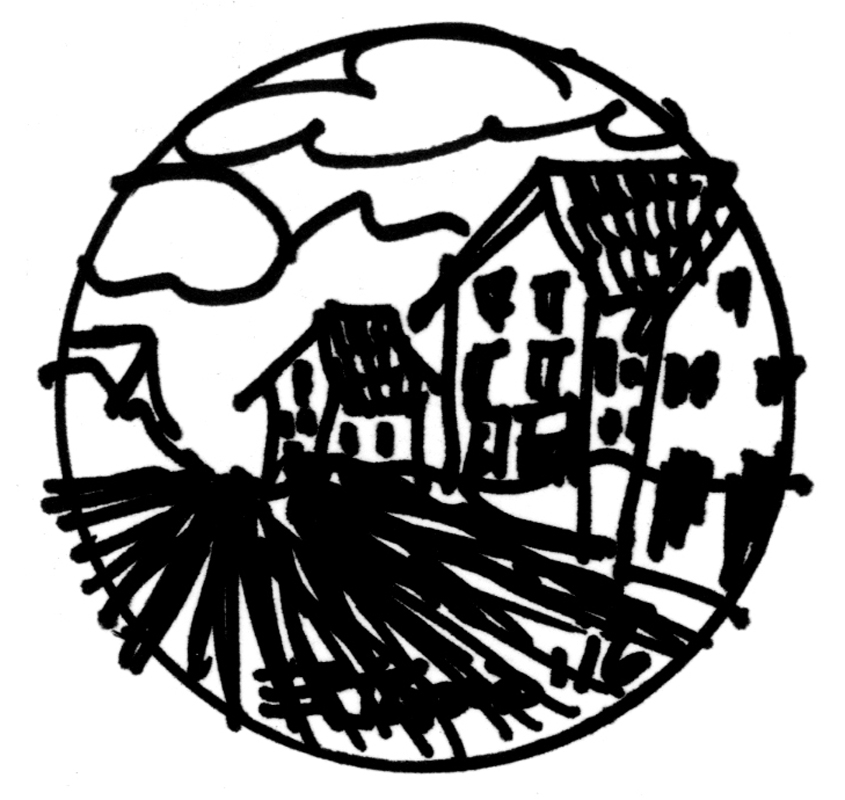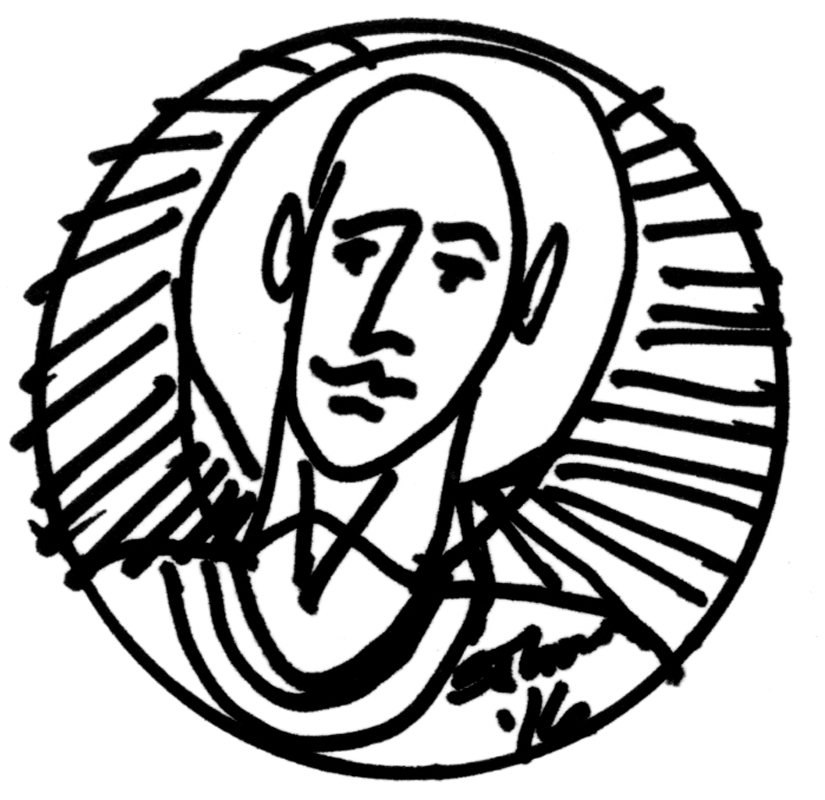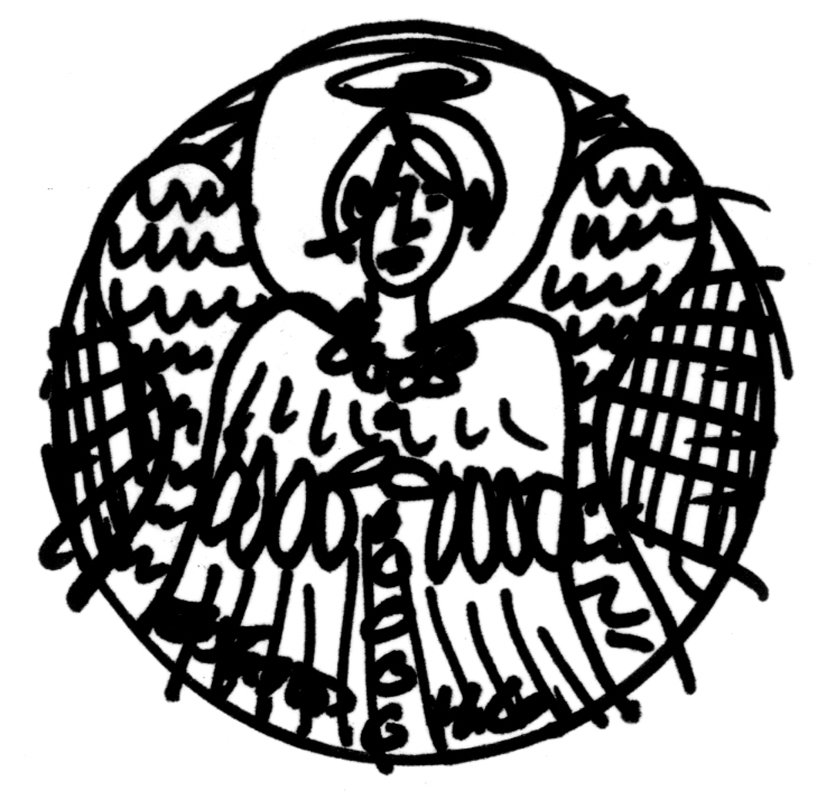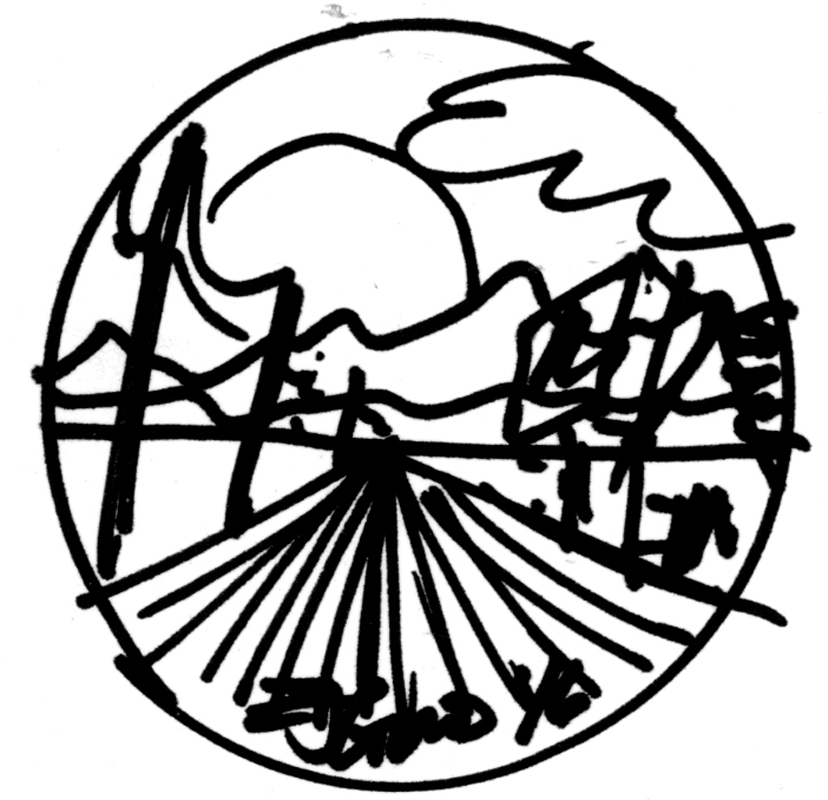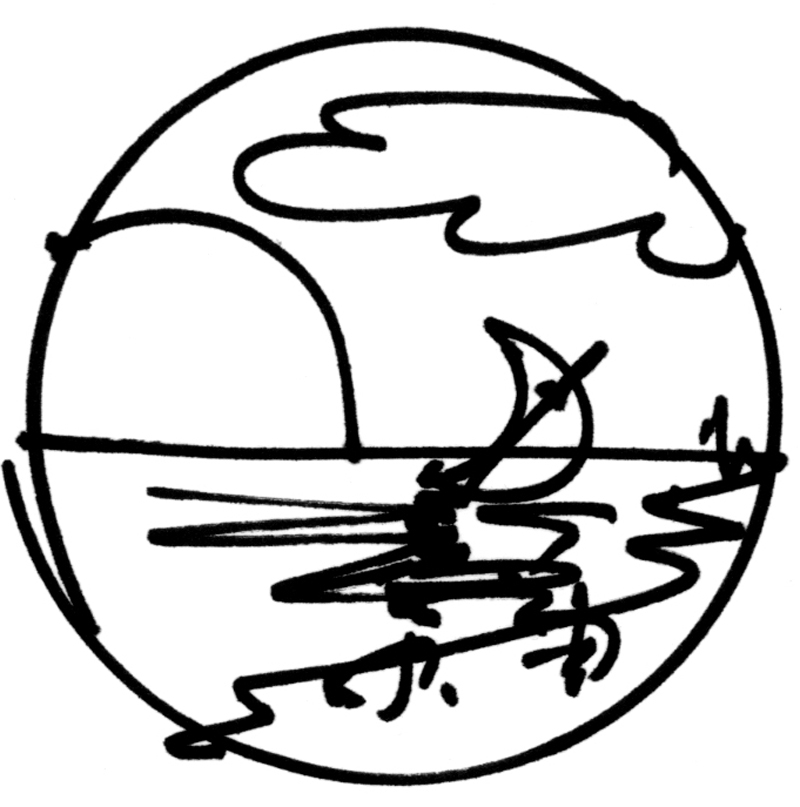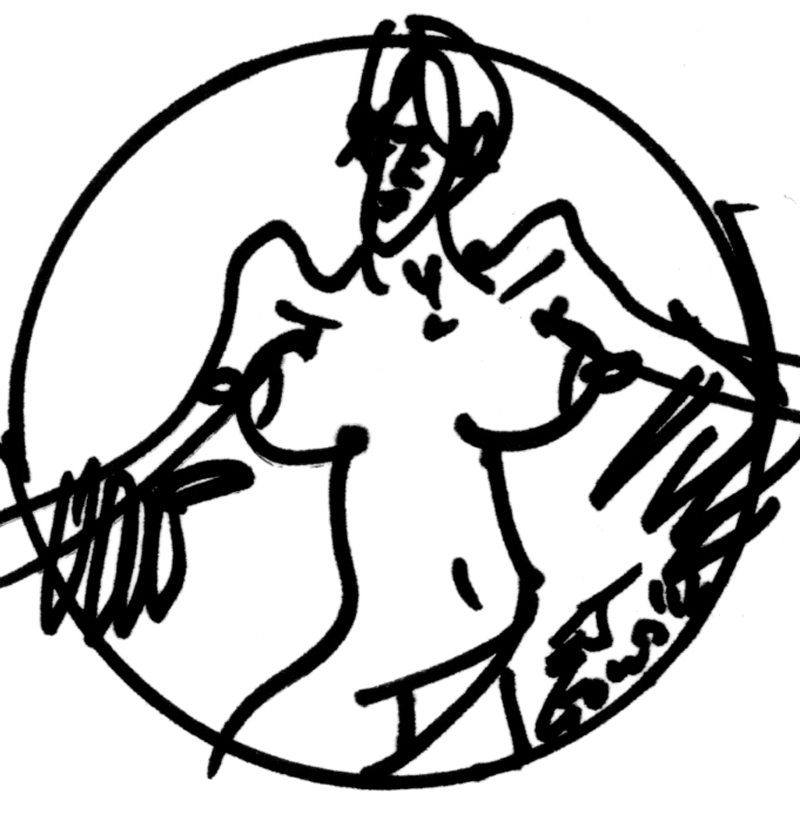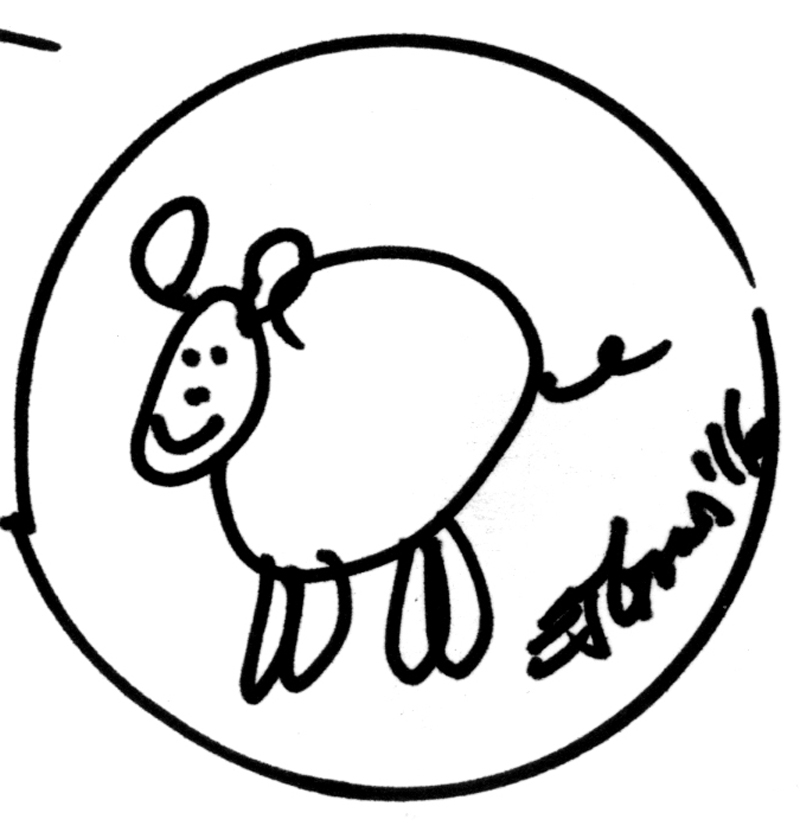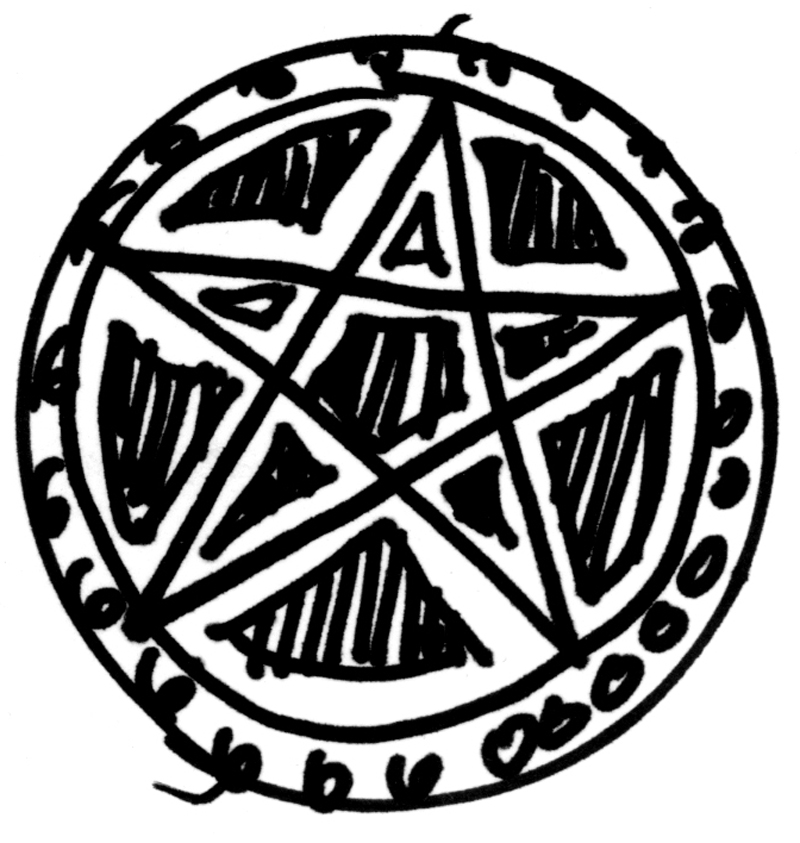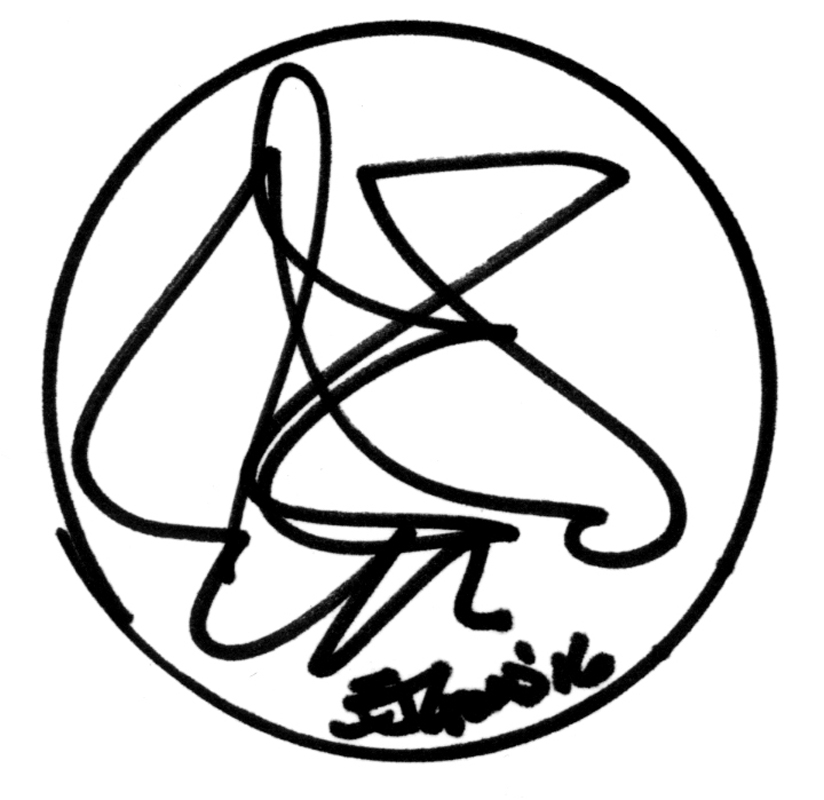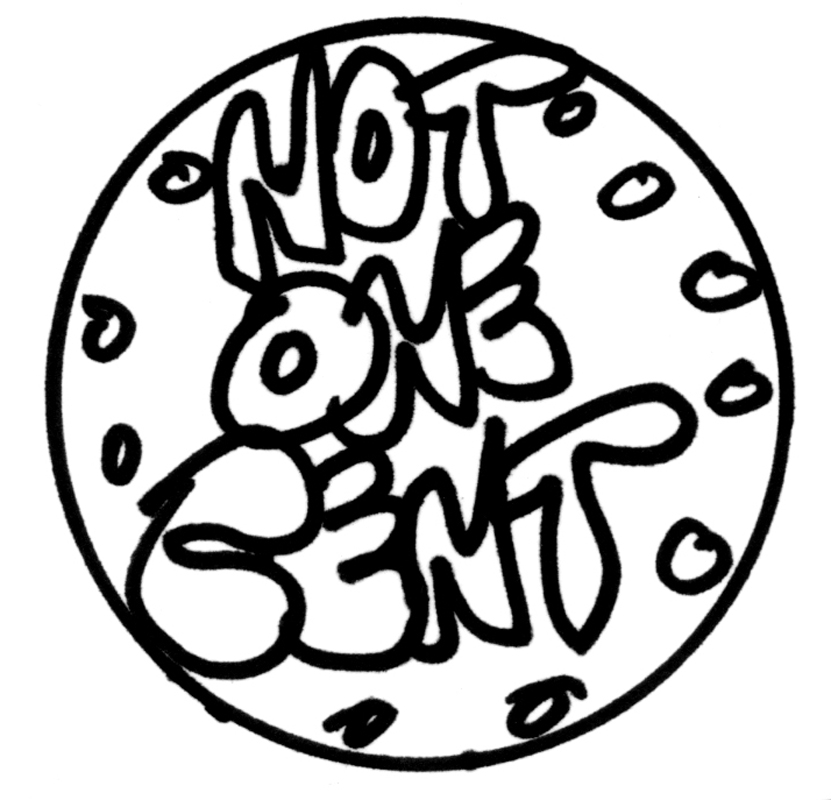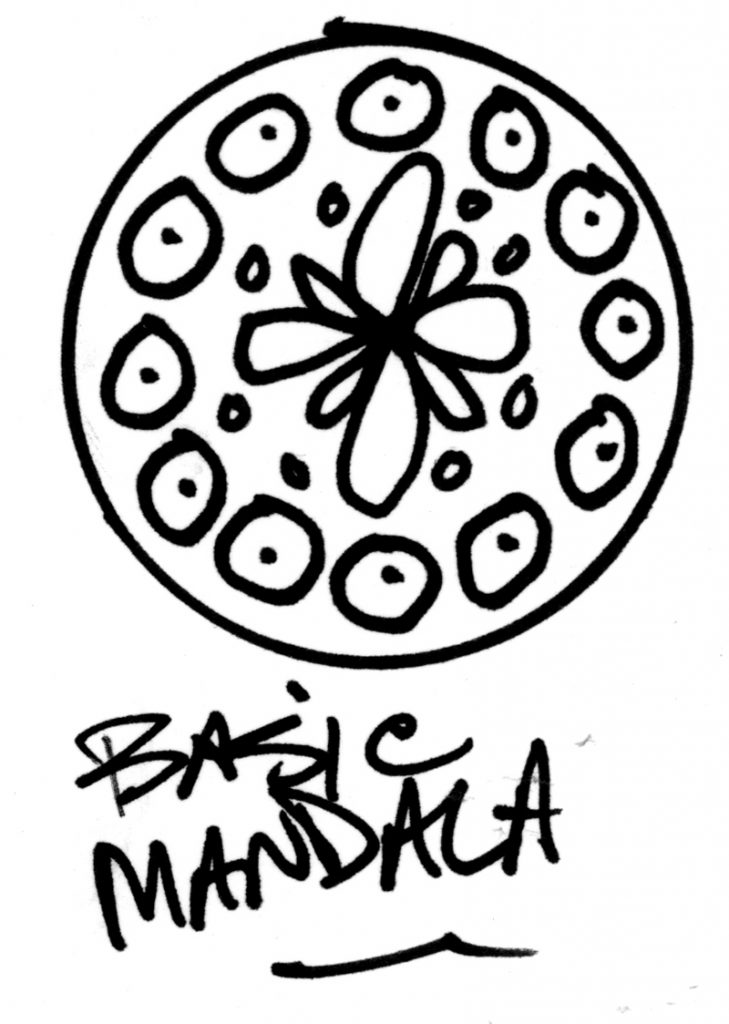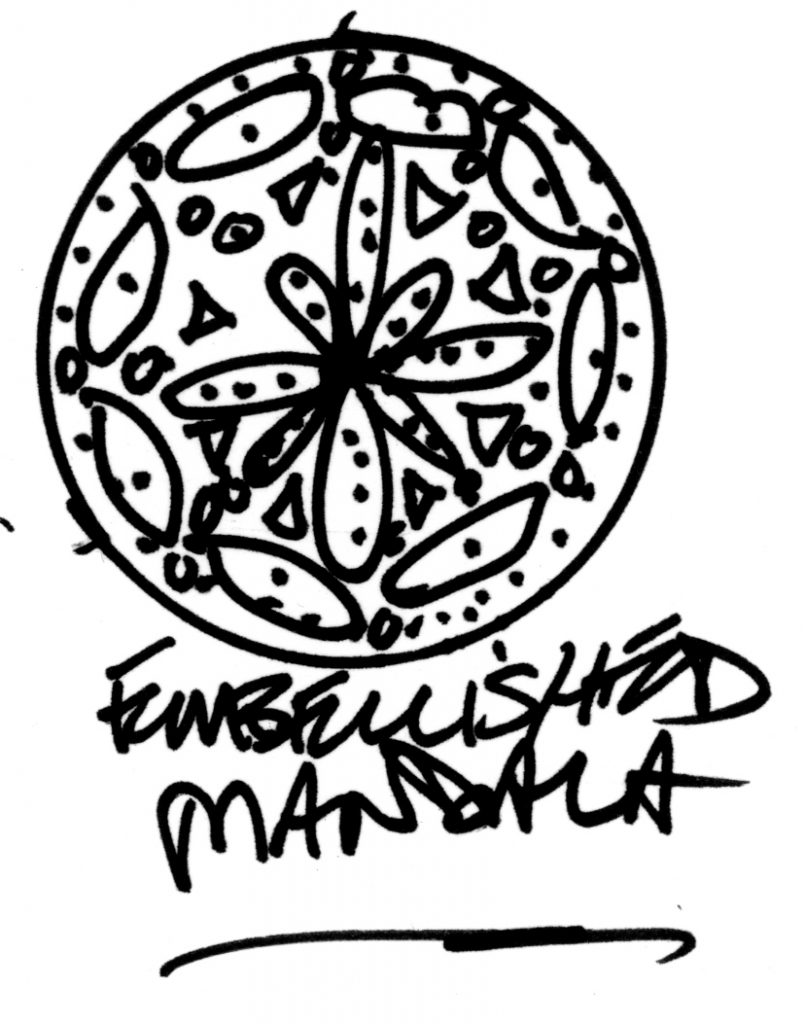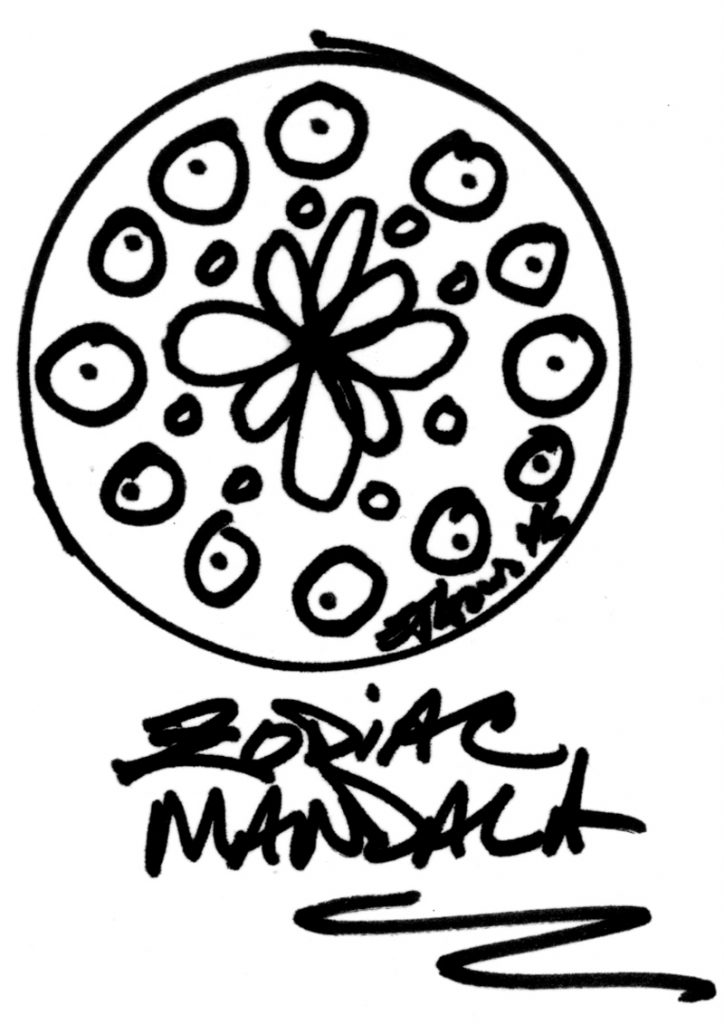This Dinosaur Skull is my “take” on T-Rex, but it could just as easily be read as a super closeup of a brontosaurus feeding on the top of a tree — it’s all in the label, in this case, but you could get very good at reducing the elements of a meat-eater predator as opposed to a leaf or branch browser.
Of course, ANY animal will work here, alive or dead, currently in stock or extinct.
You’ll want to sharpen your skills at shapes. Note that the teeth are long and sharp, and very exaggerated, as are the double-circled eyes, bulging out from the top of the skull.
I like to sign these opposite the majority of the “weight”, so in this case, I signed it on the eastern side of the rim, meaning the right side of the image.
The UFO Mandala is a very powerful “vote” for contact, and shows really well in a case or worn as a pendant. The flats of the outer melon shapes do best when they’re left alone.
The inner circle is similar to a circle of stones, a henge — it alternates between long shapes and small round shapes, as you’ll notice.
The central circle should be slightly off-round, to match the roughness of the rest of the image, and to imitate the stone-circle monoliths found at many UFO landing sites.
Please don’t take the example above as a crop circle of any note — I drew this as a quick example of how you might indicate a crop circle in a medallion, and this is it.
If you study the more solid examples of crop circles — the ones that can be definitely eliminated as hoaxes but whose origin and purpose are as yet unknown — you’ll find some that should be easy enough to copy onto metal, and recognizable enough as a crop circle to interest some people, and possibly even make some sales.
There are a LOT of different crop circles, some very neat and tidy, some rather complex and messy.
You’ll find simple designs and very complicated ones, too. I recommend a Dover book on the general subject of simple designs of ancient times, notably Greek and Pre-Columbian, for starters.
These simplified designs lend themselves well to the metal foil medium. You might even find dozens of inexpensive books in the Dover art designs list that might interest you, including Art Deco, Egyptian Designs and more.
Cartoon Head Skull is very similar to the Cubist skull, but there are definite differences, which I wanted to be sure to include here. Note the waviness of lines, the sudden change of direction of lines and the ease with which they were drawn.
None of those features are available in an engraving, although the apparent effect can of course be duplicated, with some serious highly-skilled effort.
The teeth are single-line, just roll and roll and roll to make ’em. Everything is deliberately sketchy and not very solid, to promote the impression of Fine Art rather than commercial.
The signature is, as usual for this type of piece, on the left western side of the circle.
This country road and small village street is just one example of thousands I’ve drawn taken from landscape scenery in 17th century Nederlands — Holland, to you.
The Neder, or low, lands are a terrific subject for landscapes, notable for their cloud formations and rather greyish, grim atmospherics.
My Dutch Masters Landscapes run the gamut from cityscapes and country homes to fishing scenes on the Amsterdam canals and people standing on a bridge.
Just about any landscape can be reduced and rendered, if your eye is capable of high discernment. If it isn’t, train it to be.
If you don’t have PERSPECTIVE skills, your landscapes will mostly be crap, but take heart — people LIKE crap, and tend to buy on the level they are capable of creating, so there are plenty of customers out there for visual garbage, although the cash register might not ring continuously.
Cash register? What the hell is “cash”???
Note that in a small landscape, I’ll not hesitate to put in clouds, rain, sun, moon, flying angels, UFOs hovering overhead — anything that fits and looks “right”, to provide interest to the scene and to promote the idea that it’s got depth as well as height and width — that is the point of most flat art, don’t ya know…???
Is the portrait above that of an Angel or a Saint? Actually, it’s an Angel or group of Angels, the ones with shining wings that are actually filaments of energy radiation, which might appear like wings to Russian Cosmonauts in July of 1984, who did report seeing what looked to them like seven “angels” in flight outside the Space Station.
Frankly, I’m not surprised. I did a fly-by on the 1969 Lunar Mission, during which I buzzed the capsule and playfully knocked on the hatch three distinct times, one, two, three, like that — which I happen to know they heard and which might very well have been recorded on audio tape at the time.
If I can do it, any passing higher being can do the same, and we’re all a bunch of playful critters, as if you didn’t know.
The radiant lines are pretty critical, and it’ll take some practice to get the lines to go just right, but persevere and you’ll succeed.
Here’s an idea for a rather complex Angel from head to waist. The circle for the head is drawn first, then the ears, the eyebrow and nose, the other eyebrow, then the mouth, then the eyes, then the neck and neckline.
Then draw in the long ovals for the fingers and thumbs, then add the robe and wings, then put in the robe markings, then the wing markings, then the background hashmarks and, of course, your signature and date at the bottom of the piece.
Of course, this is all embossed from the gold side of the foil. You can work back and forth from front to back — obverse to reverse — to create some rather amazing embossing effects.
This back-and-front working of the metal is called “repousse”; it’s a French word, more or less pronounced “reh-poo-say”.
You might find other ways to bring out details or create voluminous form. Experiment to discover more ways to work the metal, then when you’ve found some good techniques, settle on them for a while, and produce for the market.
This will give you feedback on your product. If you find that people react better to the simpler designs, you will quickly find some excuse to return to the simple forms, and you’d be right, both for the marketplace and artistically.
The artist cannot possibly judge his or her own art. Can’t be done by anyone, however objective they may be. There’s always a slight tendency to disparage one’s own art, to undervalue it.
Of course, if your art is total junk, you STILL can’t possibly grasp its value or interest to the public. You have to test the market, and I think you’ll be surprised at how receptive it can be, if you’re “on the money” with your artwork and finished product.
In a very tiny landscape like this, you want to do absolutely everything in your power to create the illusion of depth and distance.
I tend to draw in the horizon line first, to establish for my hand and eye what the parameters are, and to give me a “vanishing point” on the horizon.
In a desert scene like this, with a highway, the next thing I’ll put in will be the foothills just in front of the low mountains in the background. I would normally put in the sun and clouds at this time, then turn my attention to the mid-ground and foreground.
The road goes in, and I might scritch and scratch some lines along it to reinforce the illusion of depth and distance, because I don’t have color to do this job, going from intense color in the foreground to greyed and misty background, to give depth to the image.
I’m looking for radial lines that give a fish-eye effect on the sides, and a squeezing effect at the vanishing point, imagining some space beyond that point, but not drawing it in.
Okay, now I might put in some telephone poles and loopy wires, some cactus or yucca trees or both, a building or two, perhaps a gas station, then add a signature at the bottom.
Think it’s easy to draw something with fewer lines? Try this seascape and see how “easy” it is. Abstract is harder because you’re narrowing the attention down to a very few parts and effects.
I draw in the waterline first, and I might note here that the scan is a little off, so it might look as if the water’s going to run off the right side, which illustrates my point here entirely — water seeks its own level.
That means that water is always flat at the top, although of course there may be localized disturbances such as waves, ripples, etc.
Okay, in goes the sun and then the clouds, then the beachline, the sailboat, and any reflective squiggles you care to make at this time, then the signature and date go in at the bottom.
A nude is a challenge and a half, and here’s where you need to analyze and reduce the lines necessary to get the idea across.
The least amount of detail possible is the criterion here.
You might want to establish the face first, then hair, then neck, then arms, then the breasts and torso, then the navel and abdomen.
Lastly, you’ll add the fingers and thumbs as elongated ovals, and the nipples and areolae — that raised or differently-patterned and tinted body-part around the nipples.
You can sign it anywhere you have some room, and don’t be afraid to experiment here. Try different things to see how they create a variety of effects, then choose the effects you like best.
Yes, LIKE BEST. You HAVE to enjoy your art or it will lose its spark of life, and delivering a spark of life is what this game is all about.
Unspecified Pet is one of my favorite iconic images, and is associated with my artistic oeuvre.
I start with the head shape, then the smile, the nose points, the eyes, the ears, then the body, the legs — and feet, if I decide to add feet — and then the curly tail and no, it’s not a pig, it’s just a curly tail.
This character is also known as a Quantum Pet, and I have a number of websites that I bought for YOU if you were ever ready for them, so ask Claude how to obtain one of your very own Quantum Pet websites, if you wish to develop in that direction.
The very simplicity of this piece makes it work.
You might be tempted to embellish it, add detail, which is technically called “Tchotchke”, pronounced “chotch-keh” a Yiddish word meaning, more or less, “lots of stuff added on”.
It isn’t well-known, but the Yiddish word “Tchotchke” is related to the Russian word “Tsatske”, snowflake, which was once a romantic term of endearment in Old Russia and particularly in the city of Ludz, Poland, from whence came my family of immigrants who landed in Ellis Island in New York City in 1905 and 1909.
Tsatske also means “slut”, “tramp” and “woman of easy virtue”, a common word in any language, although you’ll be hard-pressed to find a male equivalent in ANY Earthspeak.
Sure, it’s a five-pointed star, but it’s also a pentangle, a pentacle and a candidate for a LOT of scribbling and scrawling, if you’ve half a mind to meddle with it.
I’ve put in straight lines between the single-line hand-drawn pentangle figure, but first I drew in the circle to put it in, so I’d have an idea of where I needed to stop at the points.
I don’t worry about going over the lines, and neither should you.
I then drew in some shapes between the “arms” of the pentangle, then finished them with straight slightly off-center vertical lines, which could just as easily have been writing of various kinds, or images or hashmarks and cross-lines.
The roughly drawn circles around the edge is a signature of mine, which you’re more than welcome to use if that appeals to your hand, but you might draw them very carefully and even add a dot in the center of each one, if you wish.
There’s no limit to the variations. You’ll see what I mean if you change the outer circles to squares. See? Big changes can result from very small actions, and that’s something you need to remember.
Scribbles are NOT total accidents. My drawing skills go into these scribbles, and abstract is no joke. You’re reduced here to the absolute minimum and the forms had better balance in the field or you’re gonna slide off the charts.
In short, abstract is a discipline that allows for no slop anywhere.
That’s hard to understand if you haven’t got years of experience in creating works of art. Experience produces failures and failures produce pain, and pain is the Great Teacher.
Not until we actually stick something into an electrical socket do we really believe that there’s a jolt in that thing that’s just waiting to be tickled by some turkey.
THEN we believe, when we’ve been knocked to the floor by a powerful shock, and that’s the way everything works. Nothing happens by accident.
Ritual is a sort of key.
When you find a lock, a portal, a door, the right ritual will take you through any obstruction, because the UNIVERSE IS ON A GRID and that grid behaves in a very predictable way.
If I needed a transspace ship, it wouldn’t be hard, with all the easy resources on this planet, including a few easily obtained heavy metals and rare earths, a common chemical reagent that makes the greatest purple you ever saw, plus a few key very rare but readily obtainable at a price meteorite bits, a tub of supercooled mercury, a generator-gyroscope, a revolving magnetic field in an ambient-temperature plasma bottle, and there you have it.
Of course, there’s still the matter of who makes and packs the sandwiches. A UFO will have an apparent elapsed time of just a few minutes to get anywhere, pretty much anywhen.
When it comes to space travel, I’m strictly in the Old School “Possession is 9/10ths of the Law”. Possession is the easiest form of travel, if you’ve got a ready landing pad, and there are plenty out there in every universe, just waiting to be used in this way; these Potential Avatars have no other purpose.
Message Pins. You can use the “balloon lettering” from the sixties, as I like to do, or invent your own typeography, and put a message there, then make it into a piece of jewelry or decor!
“Not One Cent” could mean so many things — everything from the thing not being a valid coin of the realm, not negotiable.
It could also mean “Not government issue”, meaning that it then falls under the exonumiat of “token”, which is more correct, even for a foil-made token, although there are some who would object to this classification.
The message is clear and simple and concise and limited to three words. Do yourself a favor and try to come up with a slogan that will fit on the disk. Good luck on this one — it’s a very challenging project that, on the surface, looks easy.
The “easy” look is deceptive as hell. Try it and you’ll see.
What the hell is a “basic” mandala? Wait, maybe we better answer the second question first — “what’s a mandala???”.
A mandala is a world-picture, a map or schematic diagram of the universe or of a special case configuration, such as a deity or high-ranking official of the Angelic Corps, and they DO exist, so be aware that you could easily run into one or more of them.
The Basic Mandala is a really simple iconic device. It features a circle of circles around the outer edge.
You’ll put in the circle to the North first — the side that’s uppermost — then the one to the South or bottom of the disk, then East or to the right, then West, or the left side of the disk.
That makes four circles in a cross. Now add two circles between each pair of those and you have the outer circle, with 12 circles around it, which may give you some clues.
Now we draw the Fleur-de-Lys in the center, all in a single unbroken line, as I demonstrate on video.
Add the flying circles between the arms of the flower, and you’ve got the Basic Mandala. You have but to Sign, Seal and Deliver!
If you find yourself sitting at a fair with nothing to do, try embellishing a few mandalas like the one pictured here. This uses dots made from both the front and the back of the piece, plus closely woven smaller design elements in the form of smaller circles and triangles.
There’s really no limit to the amount of embellishment you can bring to the table here. If you’re a specialist at miniature Ukrainian Easter Eggs, you should have no trouble at all creating some seriously weird and wonderful effects within the Metallic Mandal.
You will eventually learn to use the reflective surface and flat areas of the disk to your design advantage.
Embellished doesn’t mean “junked up” or “over-wrought”. Embellished means exactly that — embellished. That means the additional markings ADD to the effect, they don’t take away from it by cluttering things up.
Pushing ridges in metal creates some amazing quantum effects, and it’s the small that directs the large — the World of Quantum directs the Newtonian-Einsteinian World, and don’t you forget it.
I mentioned that you get 12 circles on the disk when you make them as I’ve outlined above, and that should have suggested The 12 Signs of the Zodiac, the foundation of Astrology, to you as a crafter.
Okay, so let’s see what elements we have that can work here… how about astrological symbols? How about illustrating the person’s Natal or Progressed Chart?
That’s what I’d do — offer a combination of Progressed Chart along with an inscribed Magical Medallion, maybe in a fancy bezel, all for the low, low price of…. $?????
That’s up to you, and the outcome of that battle between you and your self-esteem is uncertain at the moment, but I’m sure you will prevail.
(TO BE CONTINUED)
See You At The Top!!!
gorby


